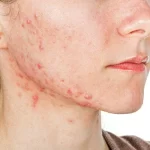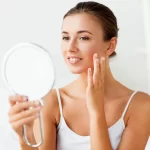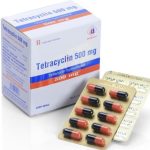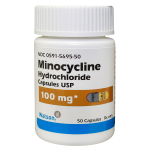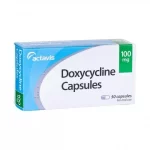Many people develop acne due to hormonal imbalances and seek out one or more hormonal acne treatment methods. A hormonal acne treatment is a special treatment that is aimed at, not only dealing with the acne related eruptions caused by hormonal imbalances, but also at remedying the hormonal imbalance that causes the acne eruptions to occur in the first place.
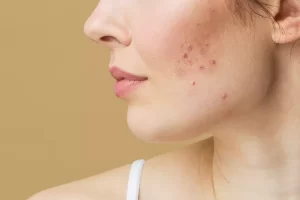
What is Hormonal Acne?
The severity of hormonal acne can vary from one person to another and is directly proportionate to the imbalance of hormones within the body as well as the cause of the hormonal imbalance. When a person develops a hormonal acne condition, unsightly pustules appear along with tiny red papules. These marks can appear anywhere on the body, but are quite common on the forehead, nose, cheeks, chin, chest, back, arms, legs, buttocks, and torso. They can also appear on the neck and chest region of the body. Sometimes hormonal acne conditions can prove severe with the appearance of nodules that are painful or tender. If a good hormonal acne treatment is not implemented, eventually the condition can lead to unsightly acne scarring and continued eruptions.
A hormonal acne treatment is commonly sought out by males and females who are going through puberty, or by females that develop acne eruptions before, during, or following their menstrual cycle. A hormonal acne treatment also works for premenopausal, menopausal, and post-menopausal women who have acne issues because of hormonal imbalances triggered by dramatic life changes. Sometimes stress and hormonal imbalances will work together in creating an environment ideal for acne growth. Usually imbalances in hormones like testosterone, oestrogens, androstenedione, and progesterones can contribute to acne flare-ups. Hormones associated with insulin control or production play an equal role in the development of acne in some people, and on occasion, some medications can create hormonal imbalances leading to acne formations.
Hormones in women like progesterone, oestrogen, low-level testosterone, and androstenedione, are hormones responsible for stimulating the female libido. These sex hormones are created by the ovaries, and released into the body, however, they can also be the inciter of oily skin, excess facial or body hair, and can prove a main factor in acne onset. Meanwhile, when a female experiences a great deal of stress it can force the body to overproduce male hormones: this too results in acne eruptions.
Some women experience conditions like Polycystic Ovarian Syndrome. The latter condition can result in the development of excess body weight despite a healthy diet and exercise, the onset of irregular periods, infertility, and hormonal acne eruptions. With obesity issues, the body can convert oestrogen hormones into hormones that act like androgens; when this happens the body begins generating more sebum and oils, both of which contribute to acne outbreaks. Research has found that obesity issues make hormonal acne conditions more different to deal with, even with a powerful hormonal acne treatment.
Hormonal acne can be triggered by insulin resistance and diabetes too. When a person has diabetes or is insulin resistant, blood sugar levels in the body are increased. This can cause a female’s ovaries to be over stimulated, resulting on cyst formations, infertility, menstrual irregularities, and in the creation of excessive testosterone like hormones in the body. Even some oral contraceptives, once stopped, can cause hormonal imbalances that will later call for the need of a good hormonal acne treatment. In fact, some women using pills comprised primarily of progestogen can end up having excess sebum and acne as a result. Finally, some fertility medications can help make one more fertile, but can simultaneously promote the onset of undesired acne conditions too.
There are several indictors a female can use to identify hormonal imbalances. First, irregular periods are often a sign that something is amiss. If your periods do not fall within a 24 to 28 day cycle and have proven unpredictable, hormonal issues can be the cause for the irregularity. Many women have normal androgen levels in the blood, but roughly 10% of females will develop an imbalance of testosterone/androgens. When this happens, the female may develop a darkening of skin areas like the armpits or neck, and male patterned fat distribution with fat prevalence in the torso area can also occur. Sometimes an imbalance of androgen can result in hair loss, excessive hair growth, facial hair, and oily skin.
The Solution – Hormonal Acne Treatment
There are several methods you can use if you want to deal with hormonal acne; you may even want to combine one or more hormonal acne treatment solutions to gain maximum results. Hormonal acne has been found responsive to the use of oral antibiotics, medicated creams, and topical applications. You can also implement lifestyle changes that can improve hormonal balances and restore bodily health.
For females who find themselves dealing with a particular severe case of hormonal acne, sometimes a doctor will offer an oral contraceptive with or without spironolactone, an anti-androgen, to alleviate imbalances that prove the source of acne outbreaks. The latter type of treatment is ideal for females seeking a long-term hormonal acne treatment. Spironolactone will produce positive acne reducing results in as little as a month’s time. Within a two-month period, the improvements of your skin condition are very noticeable. This remedy is offered in a dose ranging from 50mg to 100mg, and it is taken on a daily basis. Some side effects associated with the treatment include things like heavy periods, irregular periods, and tender breasts, but if the Spironolactone is taken along with an oral contraceptive, you are less likely to experience the latter side effects.
If a women is experiences a hormonal imbalance brought on by diabetic conditions or insulin resistance, an ideal hormonal acne treatment is identified in metformin. The latter medication is often used in the treatment of diabetes, but it can normalize insulin levels and androgen levels in insulin resistant individuals as well. A secondary advantage includes the fact that the medication will help in losing excess weight too. This remedy can take two to twelve months to see the maximum effect of its use, but improvements in skin conditions can be witnessed in two to six month’s time.
Sometimes women are supplied with contraceptives like Microgyon 20 or Loette, both containing low androgenic levels. These contraceptives have proven beneficial for females with acne related conditions because they help to minimize the size of skin pores, diminish oil production, and within three cycles of the medication a female can note significant skin improvements. Microgyon 20 and Loette may be offered in a combination hormonal acne treatment too: the two medicines combined have low levonorgestrel and oestregon levels. While excellent for acne, combining Loette and Microgyon can result in break through bleeding in some females. In addition, oral contraceptives containing progesterone cyproterone acetate have proven helpful in dealing with severe acne eruptions. Women using contraceptives for acne control can endure some side effects including weight gain, breast tenderness, spotting, nausea, and altered moods.

